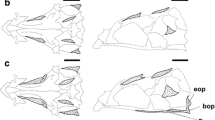Abstract
A study of laboratory-reared larvae of Solea solea (Soleidae) and Scophthalmus maximus (Scophthalmidae) indicated that the epicranial portion of the dorsal fin results from the anterior displacement of proximal pterygiophores during ontogeny. The adult epicranial formula is attained early during ontogeny, and the anterior displacement is finalized after the passage of the migrating eye. In both species, the first two proximal pterygiophores fuse to form an erisma that is particularly long and well-developed in Solea. Moreover, in Solea, the neural spine of the second abdominal vertebra curves over the otic region, and the neural arch of the first vertebra remains incomplete.
Similar content being viewed by others
Author information
Authors and Affiliations
Additional information
Received: August 3, 2000 / Revised: August 10, 2001 / Accepted: October 12, 2001
About this article
Cite this article
Wagemans, F., Chapleau, F. & Cooper, J. Ontogeny of the epicranial portion of the dorsal fin in Solea solea and Scophthalmus maximus (Teleostei, Pleuronectiformes). Ichthyol Res 49, 89–92 (2002). https://doi.org/10.1007/s102280200011
Issue Date:
DOI: https://doi.org/10.1007/s102280200011



